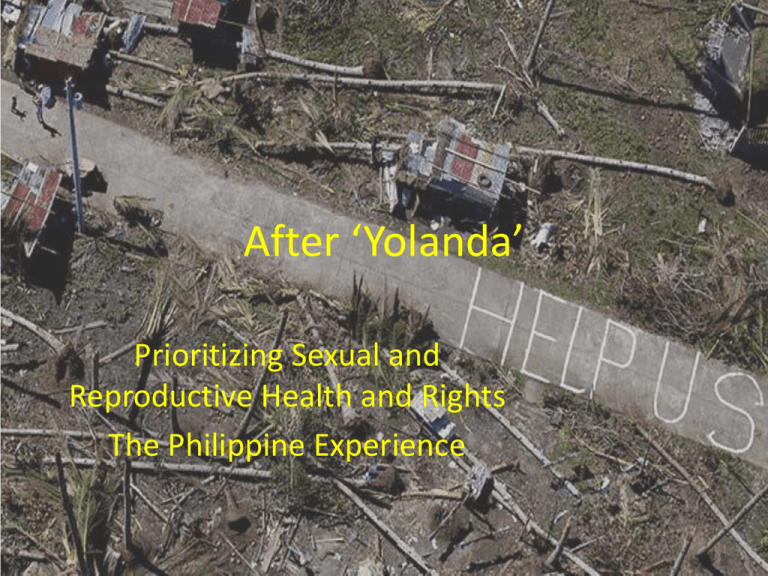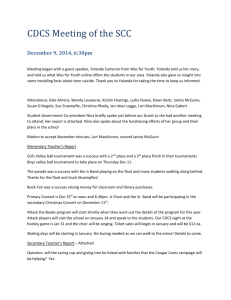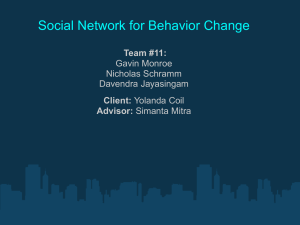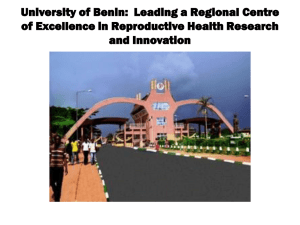
After ‘Yolanda’
Prioritizing Sexual and
Reproductive Health and Rights
The Philippine Experience
Before ‘Yolanda’
• Poverty, landlessness and sexual exploitation were already major
social and economic problems for the people of Eastern Visayas,
which was considered the third poorest in the Philippines (Oxfam
assessment)
•
Situation was exacerbated by weak infrastructure and struggling
agricultural and fishing sectors, with almost two million people
earning less than $2 per day,
• Women were especially vulnerable. “Eastern Visayas is known as a
source of women and children for sexual exploitation, and men and
boys for labor exploitation. This is primarily due to the high poverty
incidence in the region.” (IOM’s National Project Development Officer
Romina Sta. Clara.)
When Yolanda struck
When news of the “Super Typhoon” emerged, the national
government immediately issued a warning to all areas
under threat, with President Aquino even launching an
unprecedented national televised address warning the
people about the coming disaster
Some national officials (including the defense and local
government chiefs) were deployed to Leyte to oversee the
preparations and response to the typhoon
When Yolanda struck
• As Yolanda approached the Philippines, approximately 800,000 people
were evacuated and disaster response personnel and equipment were
quickly deployed. Such immediate action by the authorities, say aid
agencies and local responders helped save many lives and facilitated the
subsequent relief effort.
• Yolanda was the strongest
typhoon to make landfall ever
recorded, with wind speeds of 315
kph (195 mph). The accompanying
storm surge sent a wave up to five
metres high smashing through
coastal communities, killing many
who thought they were safe.
After Yolanda
• Shortly after the disaster, the government estimated
that more than 2.1 million families were affected by
Yolanda, equivalent to around 9.53 million individuals
(DSWD), with majority found in Leyte and Samar, but
also Aklan, Iloilo, Palawan, Bohol and Bicol
• Some months later, in an assessment, Oxfam put the
number of affected individuals at a much-higher 15
million, with at least 5,600 killed and over 26, 200
injured
• Over four million are still displaced from their
homes,with 1.2 million homes damaged or destroyed
After Yolanda
• DSWD also estimates some 96,039 displaced families with
449,416 individuals staying in 1,790 evacuation centers. Some
36,600 other families composed of 182,379 individuals have
sought shelter in homes of friends and relatives.
• Among those affected by the typhoon were front-liners like
police and soldiers, social workers, medical and rescue
personnel, with the local governments in affected areas
practically paralyzed
• Lack of power and communication facilities hampered
immediate rescue and relief efforts
Response to Yolanda
Outpouring of relief and
assistance from both the national
government and foreign
governments
UN designated its disaster
response an “L3” – its highest
classification, with UN emergency
response team reaching Tacloban
within 12 hours of Yolanda striking
land
• At the request of the business community, whose establishments had
been subjected to looting by survivors, among the first personnel to be
brought to Leyte and Samar were police and soldiers for peacekeeping
duties, with personnel from the Department of Health, the Department of
Social Welfare and Development and other agencies closely following
Response
• More support mobilized by international organizations
and agencies, including the Red Cross, IOM, Fuel for
Relief Fund and thousands of individual donors
• So far, an estimated three million people have received
food assistance including rice, high energy biscuits and
emergency food items
More than 35,000 households received tarpaulin sheets
or tents (particularly in Eastern Samar and Leyte
provinces) with efforts to reach another 478,000
households under way
Response
• About 80 per cent of people still in Tacloban City
had access to clean water and about 60,000
hygiene kits had been distributed.
• This and other aid – including health care,
services to protect children, and cash transfers –
have helped keep families alive, prevented
outbreaks of disease, and begun to help people
to rebuild their lives.
• In the context of Yolanda’s severity and the
logistical challenges it created, these are notable
successes. (Oxfam assessment)
Reproductive Health Issues
• DSWD counts 233,697 pregnant women affected by
the typhoon and requiring specialized reproductive
health services. In evacuation centers alone where the
displaced are temporarily housed, a total of 7,973
pregnant women had been counted as of late last year.
• “The biggest challenge is really the continuation of
maternal healthcare services. With so many health
centres destroyed, women have no place to go for their
pre-natal examinations. Midwives will have to go find
the pregnant women, but often the midwives are also
among the affected population.” (Amelita Robles, provincial health
officer)
Repro Health
• -- Health experts fear conditions in evacuation centers can
put pregnant women at heightened risk of malnutrition and
pre-term labour. “In the centers, she is dependent on food
rations, which are usually rice and canned goods. These will
not provide the necessary nutrients that a pregnant woman
needs” (UNFPA officer)
• Malnutrition in pregnant women can also increase the
chances that their babies will be sick, or die.
• The psychological trauma of a disaster on the scale of
Yolanda may bring on premature labor, say health workers,
and if the baby is delivered pre-term, there is a lower rate
of survival
Repro Health
• The needs of pregnant women from [confirmation of] pregnancy
to… giving birth need to be integrated into emergency and relief
response (FPOP)
• Of the 14.4 million affected people, 25% are women who are of
reproductive age, which is equivalent to 3.6 million (IPPF)
• This serves to indicate the
large number of women
who could get pregnant by
their spouses as people still
have sexual intercourse
even in times of crisis. There
are also cases of unplanned
pregnancies especially when
contraception is not used,
or when a girl or woman is
raped.” (IPPF)
Repro Health
An estimated 900 babies are born daily in the typhoon-hit
regions. But with limited access to medical facilities and aid,
newborns are exposed to the risk of respiratory complications
and infections, and mothers to childbirth complications and
obstructed labor that can result in death.
• Yet these deaths are mostly preventable if a basic and
sterile delivery kit is available. A simple cloth can help
warm the baby against developing cold or hypothermia,
while clean gloves can be used to contract a mother’s
uterus to prevent excessive bleeding post delivery.
Minimum Package
•
These life-saving items are often taken for granted
until times of emergency, amid chaos and ruins, when
we realize they are not readily accessible. Even a clean
blade makes a difference in ensuring the umbilical cord
is cut without an infection hazard.
• Under the internationally approved Minimum Initial
Service Package (MISP) for reproductive health, certain
activities must be implemented at the onset of every
emergency, including distributing emergency delivery
kits to displaced pregnant women in their last
trimester. The emergency kits for women and
traditional birth attendants to aid safe delivery may
contain a plastic sheet, a razor blade and a bar of soap.
Ongoing challenge
• Sexual and reproductive health service is one area that
hasn’t been adequately recognized by humanitarian
responders and communities on the ground. In the
Philippines, it remains an ongoing challenge, as access to
reproductive health rights is often faced with opposition
due to religious and cultural sensitivities.
• The 2011 Family Planning Survey noted that the country’s
maternal mortality ratio jumped by 35 percent, from 162
deaths per 100,000 live births in 2006, to 221 in 2011. And
still, the Responsible Parenthood and Reproductive Health
Law is still undergoing deliberations in the Supreme Court
VAW and trafficking
• In emergencies, desperation drives families to seek
alternative sources of income, and adolescent girls and
women may have to engage in transactional sex or fall
prey to human trafficking (Save the Children)
• Domestic violence is also likely to increase as
frustration grows within the family unit and women
and girls bear the brunt.
• Of the millions of people affected by the typhoon, an
estimated 56,400 women between 15 and 49 years old
are at risk of sexual violence. In the evacuation centers,
around 2,500 women are at risk.
Facilities for women
• UNFPA-organized reproductive health medical
missions
• Creation of at least 17
‘women-friendly’ spaces,
providing information
sessions on the
prevention of genderbased violence and
psychological counseling
• “Women’s gardens” in
Samar
Disadvantages
• On top of the increased risk for gender-based violence,
women who lost their husbands to disasters may find it
difficult to retrieve property, receive compensation for
destroyed homes or gain access to loans because
family property is usually in their husband’s name.
There is also a consensus that women are less likely to
survive disasters, and that planning and warning systems
need to be responsive to this reality. Women and girls are
less likely to know how to swim and have less upper body
strength required to hold on to trees or other anchors
(Ferris)
Trafficking
• Currently, local government units and social
workers have been alerted regarding the
possibility of trafficking of children in Yolanda
areas, whether for sex trafficking or forced
labor, and are coordinating with national
agencies
• Need for better coordination regarding
policies, programs and actions on the welfare
of Yolanda orphans (New York Times story)
What needs to be done
•
For the Philippine government:
•
Ensure that services to protect vulnerable groups, such as
women and children (and elderly), are rapidly expanded. These
should include access to trained protection staff and domestic
violence telephone hotlines; increased deployment of female
police; and women-friendly spaces in displaced communities.
•
All of these steps should be supported as a crucial part of the crisis
response and not as a secondary issue (alongside of course
measures to ensure ‘safe programming’, so that no part of the
response increases risks for women, girls or other vulnerable
groups).
What needs to be done
• By the Philippine government
• Deliver a pro-poor reconstruction strategy that
spearheads a major economic development of
the worst affected regions and tackles
inequalities, including gender, that make people
vulnerable.
• The strategy should involve communities
(including women’s groups) in the design and
implementation of structures, especially
residences
For UN and Int’l NGOs
• Continue to increase support to the Philippine
government and state institutions, as well as civil
society organizations, in order to accelerate the
response and ensure sustainability of the
recovery and reconstruction efforts.
• International actors should integrate their
activities with those of domestic actors, avoiding
the establishment of parallel service provision
and uncoordinated investments.
UN and int’l NGO’s
• Strengthen gender analysis across all programs
and implement projects accountably and on the
basis of the needs and priorities of different
groups.
• This should include actively supporting women’s
leadership and women’s organizations, and
looking for other opportunities to ensure that
relief and recovery programs help to promote
gender equality in the long-term. (Source: Oxfam assessment)









